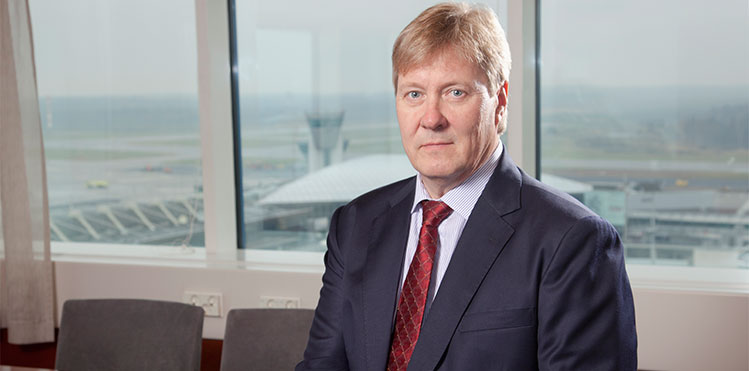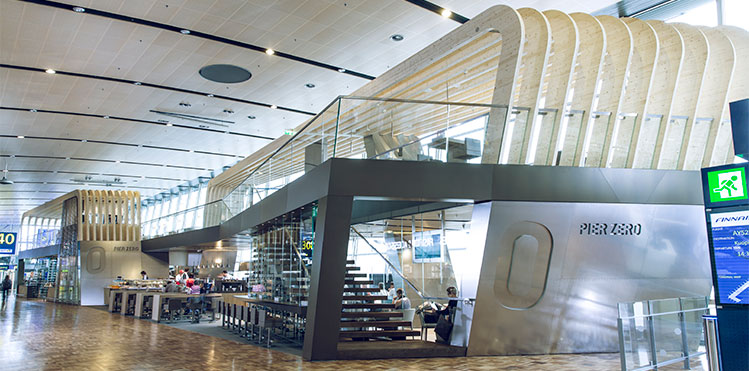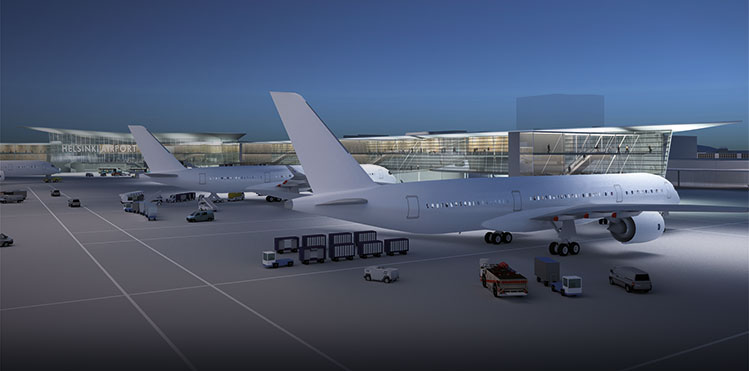
Kari Savolainen, CEO Finavia: “When it comes to connectivity, our geographical location, providing the shortest route between Europe and Asia, is surely beneficial. However, it is not only our location that has made us successful – our transfer times, for example, are among the shortest in Europe.”
An interview with Kari Savolainen, CEO Finavia. By Ross Falconer
Helsinki as a destination is a mix of rural and urban. In just one day, you can experience the tranquillity of Finnish nature, street food festivals, a traditional Finnish sauna, historical monuments and modern museums, and urban clubbing, to name just a few examples. It is a mix that delegates at the 25th ACI EUROPE Airport Commercial & Retail Conference & Exhibition, hosted by Helsinki Airport, will be able to enjoy.
They will also experience an airport that is growing, both in terms of passenger numbers and infrastructure. Helsinki Airport grew by 3% to a record 16.4 million passengers in 2015, and this pace of growth is reflected across Finavia’s network of 22 airports. Traffic across the network rose to over 20 million passengers for the first time last year. “There were increases in both domestic and inter-national traffic,” explains Kari Savolainen, CEO Finavia. “As a result, Rovaniemi and Ivalo in Lapland both set an all-time passenger volume record, and Oulu was once again in the million-passenger club. Tourism in Lapland is recovering to almost the same level it was in its peak years, with over one million travellers for the first time since 2008.”
The air transport sector accounts for about 3.2% of Finland’s GDP and provides employment, either directly or indirectly, to some 100,000 people. The strategic geographical location of Helsinki Airport as “the shortest route between Europe and Asia” is central to its connectivity. “The number of transfer passengers at Helsinki Airport increased by over 3%, reaching 2.6 million in 2015,” Savolainen comments. “The majority of Asian passengers were from China and Japan. The growth in transfer traffic between Europe and Asia is estimated to continue, so it is clear that we will focus heavily on Europe-Asia transfer traffic in the years to come.”
Helsinki’s connections to 130 destinations worldwide this year include 17 direct routes to Asia. In January, Finavia signed a partnership agreement with the biggest airport operator in China, Capital Airports Holding Company (CAH), becoming the first European airport operator to do so. “This is a significant step for us in strengthening our position as the leading transfer hub between Europe and Asia,” Savolainen enthuses. “Due to this partnership Helsinki Airport signed a sister airport agreement with the biggest airport in Asia, Beijing Capital International Airport. We are confident that these agreements will benefit both parties in building even better connections between the two continents.”
Helsinki Airport factbox
2015: 16.4 million passengers
2015 PASSENGER TRAFFIC GROWTH: 3%
2016 PASSENGER GROWTH (YEAR-TO-DATE): 6.4%
KEY AIRLINE CUSTOMERS: Finnair, Norwegian, SAS, Lufthansa, KLM
NUMBER OF ROUTES: 130
TOP 5 DESTINATIONS: Stockholm, Oulu, London, Copenhagen, Amsterdam

The Helsinki Airport commercial offer has been revitalised with 70 new or refurbished shops, cafés and restaurants. The two-storey Pier Zero restaurant has become the airport’s new landmark, with Scandinavian architecture, timeless design and high-quality delicacies.
€900m investment programme
Helsinki Airport’s one-roof concept is at the heart of the convenience it strives to offer, with short walking distances and services easily accessible. This proposition will remain following the current €900 million investment programme.
The terminal expansion was launched at the beginning of the year. A new southern wing will be completed in summer 2017, add-ing 7,850sqm, and will be followed by a new west wing, which will open in summer 2020. Alongside the terminal developments, the apron area will be renovated, covering a total of 157,000sqm.
The airport has undergone a complete makeover during the past couple of years. While the expansion is only in its earliest phase, a lot has been done inside the terminal. “Our commercial offer has been renewed completely. 70 new or renewed shops, cafés and restaurants have opened at the airport,” Savolainen notes. “The two-storey Pier Zero restaurant has become the airport’s new land-mark, with Scandinavian architecture, timeless design and high-quality delicacies. Combining local products and Finnish brands with top international brands is the essence of our upgraded commercial offer.”
“Reliability, innovation, world-class customer service”
While the most visible part of the development programme is the infrastructure expansion, enhancements to the customer experience are at the very heart of the Helsinki strategy.
The airport aims to engage with travellers through some more unusual experiences. Recent examples include airport yoga, a mid-summer dance, and ‘Restaurant Day’. This all serves to enhance the airport’s proposition, which Savolainen describes as “a combination of cost-efficiency, reliability, innovation, and world-class customer service.”
“We want to make travelling even smoother for our passengers all the way from arriving at the airport, through check-in and security, to the shopping facilities and departure gates,” he adds. “With the help of the latest technologies, such as indoor positioning, we can understand passenger flows better and introduce new services to help passengers navigate and find services at the airport. Our goals are clear: Improving passenger flow throughout the whole passenger path, and providing new innovative digital services to our passengers.”
The indoor positioning technology, provided by Finnish company Walkbase, utilises both beacons and WiFi-based infrastructure, allowing the airport to track passengers throughout each stage of their journey. It is being used to help identify bottlenecks and promote location-based, personalised communications.
This is just one example of Helsinki Airport’s progressive approach. Free unlimited WiFi is a pillar of its offer, and its mobile app is now available in Chinese and also for the Apple Watch.
Meanwhile, eGates and eBoarding are currently being piloted at Helsinki Airport. It is early days, but another example of Finavia’s desire to utilise the latest technologies.
Regional developments delivering “good conditions for growth”
Finavia’s investment programme is not limited to its Helsinki hub. The biggest investment in its regional airports is taking place at Rovaniemi Airport, where the runway will be renovated in summer 2016. Rovaniemi is the third busiest airport in Finland, and passenger numbers are on the rise – 480,000 were handled in 2015 (+7.6%). “The renovation is for making sure that air traffic to the north is effective and to enable good conditions for the growth of air traffic in Lapland,” Savolainen explains.
Finavia is investing €35 million in the Lapland airports (Enontekiö, Ivalo, Kemi-Tornio, Kittilä, Kuusamo, and Rovaniemi) between 2014 and 2016. Improvements are also planned at Mariehamn and Vaasa airports.
Our Finavia briefing clearly illustrates that Finland’s airports are in better shape than ever. Passenger numbers are growing, and the ongoing investment programme is providing competitive airport infrastructure across the Finavia network.








